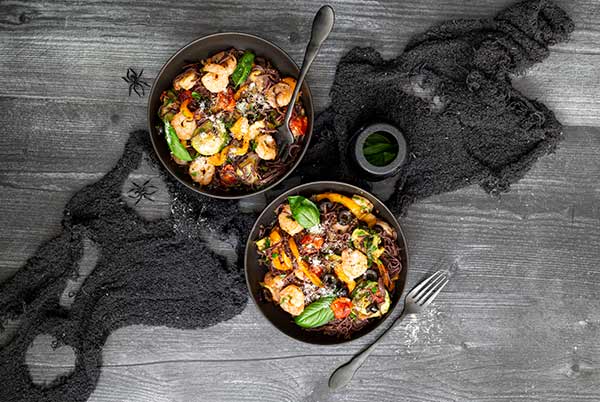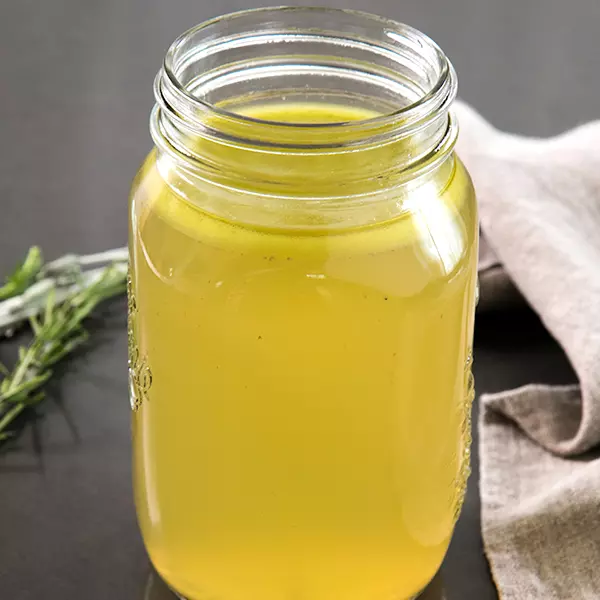Are you ready to indulge in a treat that’s both decadent and safe for everyone to enjoy? Here is a gluten free, egg-free homemade cookie dough that tastes like a dream, but won’t have you worried about eating raw eggs!
Why this is the best gluten free cookie dough that you can eat raw
This delightfully decadent eggless cookie dough recipe looks so authentic, you’d swear it’s ready to be baked into a fresh batch of cookies. But fear not, this dough is designed to be eaten exactly as it is, all without baking it.
Through a series of carefully crafted experiments and flavor tests with various gluten free flours, I’ve mastered the art of creating a gluten free version that easily rivals traditional gluten free chocolate chip cookie dough.
This recipe only requires as few as six ingredients, and you can whip it up in just under 15 minutes. Plus, you can prepare it in small or large batches, according to your liking, and save the leftovers in the fridge or freezer for enjoying later.
The only question left is: which is your favorite flavor to sneak from the bowl: chocolate chip or sugar cookie? Now, you can have them both!
Fun ways to enjoy edible gf cookie dough
Making cookie dough made to be eaten raw is just never a bad idea. Every time my family sees me making cookie dough, they ask if it’s edible raw gf cookie dough.
You can make this dough in a small batch, or even double or triple it. Shape and stash the bites in the refrigerator or in the freezer for longer storage.
Here are my favorite things to do with the raw dough:
- Make them into little cookie dough bites, and keep them chilled in a jar in the refrigerator for snacking.
- As bites, drop them into some ice cream (bonus points for homemade vanilla ice cream!). Ben & Jerry … who? No churn vanilla ice cream is just so easy and so good, particularly when you’ve turned it into homemade cookie dough ice cream!
- Add 1 to 2 tablespoons milk to the edible cookie dough, and make it smooth and creamy. Eat it by the spoonful without any guilt or worry!
- Drop them on top of warm brownies and watch as they melt slightly into the perfect topping.
- Coat them in chocolate to make decadent gf cookie dough truffles.
Gluten free edible cookie dough ingredients
In your pantry, right this very second, you likely have all the ingredients you need to make irresistible gluten free cookie dough:
- Gum free gluten free flour blend – I tried other gf flour variations, and none other created just the right texture
- Butter – your butter (or dairy free alternative) will act as the glue to hold your gf cookie dough together
- Sugar – depending on the recipe you choose, you’ll use white granulated sugar, light brown sugar, or both
- Salt – just a dash to balance all that sweetness
- Vanilla extract – vanilla adds such a rich, sophisticated flavor to the dough
- Chocolate chips or sprinkles – you might add one or the other or both or something entirely different (check out my variations below for ideas!)
What you need to make gluten free edible cookie dough: basic equipment
When I say that these gluten free raw cookie dough recipes are fast and easy to make, I mean it. In addition to the handful of pantry staples, you only need the following basic equipment:
- baking sheet
- parchment paper
- mixing bowl
- fork or mixing spoon
- microwave or toaster oven, for heat-treating the gf flour

Can I make different flavors of edible gluten free cookie dough?
Yes! With a few easy tweaks, you can turn the classic edible gluten free chocolate chip cookie dough into edible gluten free sugar cookie dough.
For chocolate chip cookies of any kind, edible raw or edible baked, you need a combination of brown sugar and granulated sugar. It’s not the chocolate chips that make the cookies or cookie dough taste like chocolate chip cookies. It’s the molasses in the brown sugar!
To make edible sugar cookie dough, we swap out the light brown sugar for more granulated sugar, and add a bit more vanilla extract. That’s all it takes to dial up that sugar cookie flavor.
And, of course, you could be really adventurous and add something like butterscotch chips (make sure they’re safely gluten free!) and almond extract. You can eat cookie dough with whatever mix-ins you like as long as they’re safe to eat without additional baking.
GF edible cookie dough variations
Using the sugar cookie recipe below, try these fun mix-ins to create even more exciting flavors:
- Toss in some sprinkles for birthday cake
- Drop in some Raisinets for chocolate raisin
- Try shredded coconut and mini chocolate chips for coconut macaroon
- Mix in some crushed gluten free Oreos for cookies and cream
- Add M&Ms, peanut butter chips, and mini chocolate chips for monster cookies
- Stir in chocolate chips, mini marshmallows, and chopped nuts for rocky road
- Sprinkle in some cinnamon for snickerdoodle flavor
- Roll your gluten free cookie dough balls in powdered sugar to make snowballs
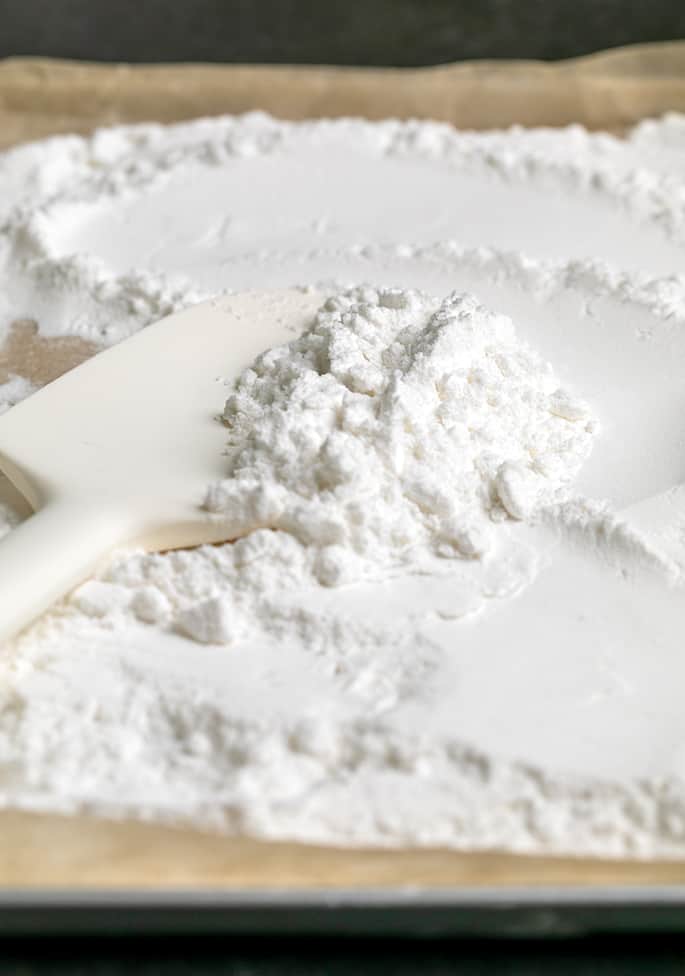
Is raw gluten free flour safe to eat?
No, eating raw flour is not safe. But it’s super easy to make safe to eat in just 2 minutes or less!
Let me show you why, and how to make raw gf flour safe to eat however you like.
Why isn’t raw flour safe to eat?
Since raw flour, like raw milk and eggs, can be contaminated with pathogens, it needs to be pasteurized before it’s safe to consume. Pasteurization is a simple process of heating food just enough to kill off anything that could make you sick.
There are two easy ways to make raw gluten free flour heat-safe. One by using the microwave, and one by using the oven (or, my favorite, a toaster oven).
How to pasteurize flour in the microwave
You only want to gently bring the flour to 165°F, without really cooking it. Grease or line a flat, wide microwave-safe bowl, and place the flour in it.
Place the bowl in the microwave and heat it for 20-30 seconds at around 800 watts (for my microwave, that means 30 seconds at 70{5676e3b156b07d12bd9df9fe13d641a85da396026abde11a1ff2d0afc1b3c015} power). Using an instant-read thermometer, test the flour temperature.
Continue microwaving in the same way and testing the flour temperature until it reaches at least 165°F. Set the flour aside to cool.
How to pasteurize flour in the (toaster) oven
To pasteurize flour in the oven, line a small, rimmed baking sheet with parchment paper. Use a spatula to spread the flour out on the paper into an even layer.
Preheat the oven to 250°F. Place the baking sheet in the oven, and allow to heat for 90 seconds.
Remove the baking sheet from the oven, turn the flour over with the spatula a bit, and test it with an instant-read thermometer. If you’ve reached 165°F, set the flour aside to cool.
If not, return the flour to the oven for 15 or 20 more seconds, and test again. Repeat until you reach the right temperature.
You can use this method in the toaster oven, or the conventional oven. I prefer the toaster oven so you don’t have to heat up the kitchen, or wait for the oven to heat up.
Why do we need flour in edible cookie dough?
Edible cookie dough needs some sort of flour to provide bulk, and give the texture and taste some authenticity. The flour shouldn’t add any depth of flavor to the cookie dough.
Edible cookie dough is designed to fool us. We want to feel like we’re sneaking a piece of raw cookie dough that’s meant to be baked. Like licking the bowl!
Do I have to use a gluten free flour blend for edible gf cookie dough?
Yes. You do need to use our simple, 3-ingredient gluten free flour blend. It’s important not to use any xanthan gum, too.
I’ve made this cookie dough using only superfine rice flour, rather than our simple gum-free gluten free blend of 3 flours (rice flour + potato starch + tapioca starch). I wish I knew why, but I didn’t like it as much.
Made with just rice flour, the cookie dough tasted somehow different. It didn’t taste like raw cookie dough that I wasn’t supposed to eat. I want to be fooled!
If you don’t want to use the gum-free flour blend, I recommend using one of my other edible cookie dough recipes. You can choose from the almond flour base cookie dough or the oat-based cookie dough.
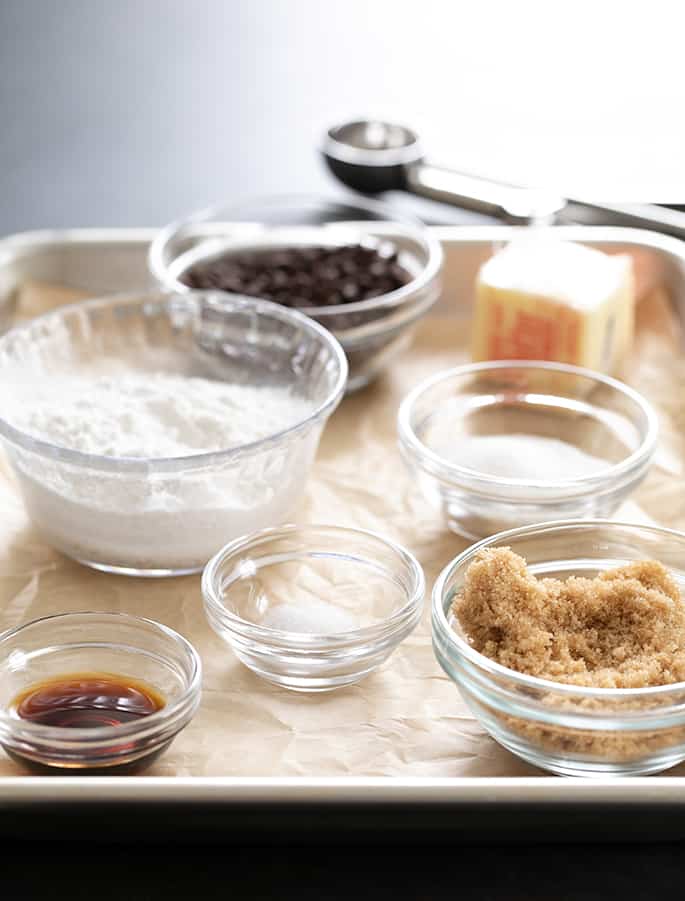
Tips for making this edible gluten free cookie dough
Absolutely delicious cookie dough is just a few ingredients away and a bit of mixing away! To help you make sure it’s the tastiest, bestest cookie dough you’ve ever tried, here are my top tips:
Weigh your gluten free flour
Keeping in mind that the flour isn’t the star of these gluten free edible cookie dough recipes, we need to be careful to use just enough of it so that it does its job. Use too much, and you’ll have a problem with competing flavors and a dry texture.
To make sure you add just the right amount of gluten free flour to your mixing bowl, I suggest that you put away the measuring cup and instead pull out the kitchen scale. Dry measuring cups for volume measurements are just not standardized in size, and human error is unavoidable.
Use soft butter, not melted
This recipe calls for softened butter, not melted. The butter actually works with the gf flour to create the right texture. If you use melted butter, the mixture will be sticky and dense.
The best way to reach the right butter consistency is to simply pull your butter from the fridge about 30 minutes to an hour before you start “cooking”.
As you only need a little bit of butter, resist the urge to microwave it to soften it. It only takes a second or two to go from softened to watery.
Serve immediately or refrigerate
This edible gluten free cookie dough is best served immediately. Unlike cookies, it can’t sit out on the counter for hungry fingers to grab at when they’re craving a sweet treat — it’ll melt!
And when I say melt, I mean it will go from a smooth, scoopable texture to something more sticky.
How to store gluten free edible cookie dough
To keep your raw cookie dough from drying out, store it in airtight container in the refrigerator. This applies to both cookie dough balls and unshaped dough. When you properly store the dough, it will last up to a week.
Can you freeze gluten free edible cookie dough?
Absolutely! This gluten free edible cookie dough freezes beautifully!
For easier handling, I suggest that you flash freeze your cookie dough bites. Shape them, put them on a non-stick pan, and pop the whole thing into the freezer.
When the cookie dough balls are hard, transfer them to a zip-top freezer bag and store for up to three months then thaw, still in the container, in the refrigerator.
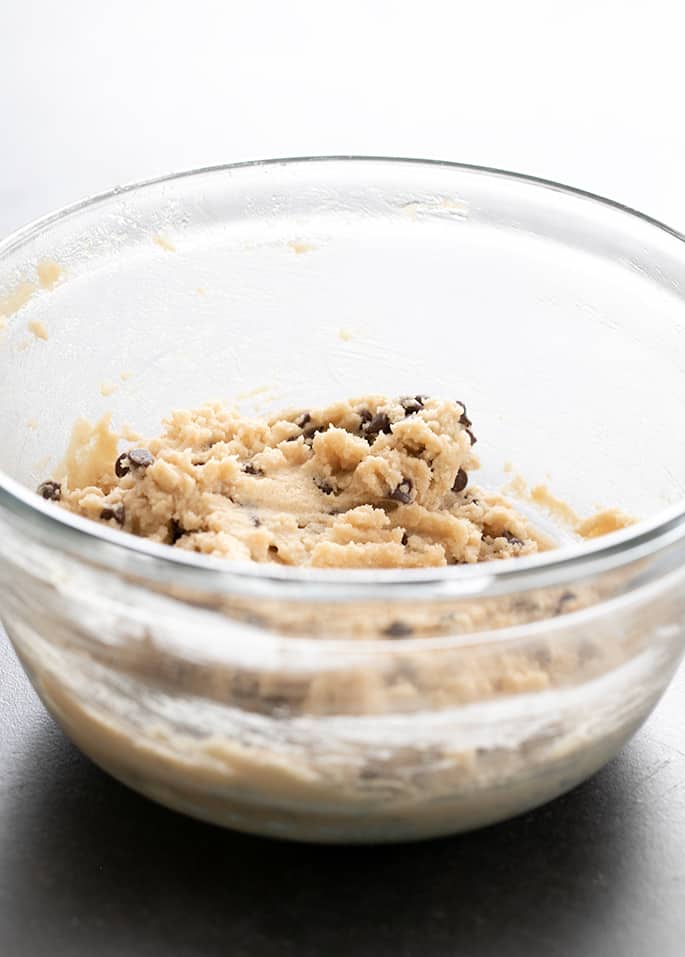
Substitutions for edible gluten free cookie dough ingredients
Gluten free dairy free edible cookie dough
The only dairy in this recipe is unsalted butter. If you need to be dairy-free, I like this recipe best with virgin coconut oil (the kind that’s solid at room temperature).
Vegan butter would also work (Miyoko’s Kitchen and Melt brands are best). Earth Balance buttery sticks might work, too, but the cookie dough will soften very quickly at room temperature.
If you need to be dairy free, choose your miniature chocolate chips carefully. My favorite top 8 allergen-friendly brand is Enjoy Life, and their mini chips are second to none.
Vegan, gluten free edible cookie dough
A lack of eggs is part of what makes this gf cookie dough recipe what it is — safe to eat right from the bowl.
This means that if you follow the advice above for replacing the dairy, and you use sugars that aren’t made with bone char, you’ve got yourself a vegan, gluten free edible cookie dough recipe.
If you decide to mix in other ingredients, like chocolate chips or marshmallows, be sure to read product labels to ensure they’re vegan too.
Gluten free, sugar free edible cookie dough
Since we aren’t baking this gf cookie dough, I think you could make it with alternative sugars. You’d need an alternative brown sugar and one to replace the granulated sugar.
I think Lankato brand monkfruit sugar alternatives would probably work quite well. They tend to be drying, though. If your cookie dough doesn’t hold together easily, add a few drops of water and mix it in thoroughly until the consistency is right.

FAQs
Is cookie dough gluten free?
No, in most cases, cookie dough is not gluten free. That’s because most recipes use traditional wheat flour. In order for cookie dough to be gluten free, you have to use a gf flour.
Is it safe to eat raw gluten free cookie dough?
If you’re referring to gluten free cookie dough that’s designed to be baked, the answer is no. Unless otherwise specified, most gluten free cookie dough recipes still use eggs and unpasteurized flour, which are some of the raw ingredients you want to avoid consuming.
What makes gluten free edible cookie dough different?
Edible homemade cookie dough may taste just like the dough you bake with, but it’s missing several key ingredients — namely raw eggs and raw flour. These are the ingredients that could carry pathogens that could make you sick if you eat them raw.
There’s also no baking powder and other minor ingredients in edible gf cookie dough, because, well, we’re not baking it with, so why include it?
Do I have to heat treat flour to make gluten free edible cookie dough?
To be on the safe side, you should definitely heat treat your gluten free flour before using it to make edible dough.
Raw flour could have germs like E. coli or Salmonella that can make you seriously sick.
Can I make gluten free edible cookie dough without flour?
Edible raw cookie dough requires some kind of binder to hold everything together. In this recipe, I use a 3-flour blend consisting of white rice flour, potato starch, and tapioca flour. After trying several varieties, this is the blend I found to work best in this particular recipe.
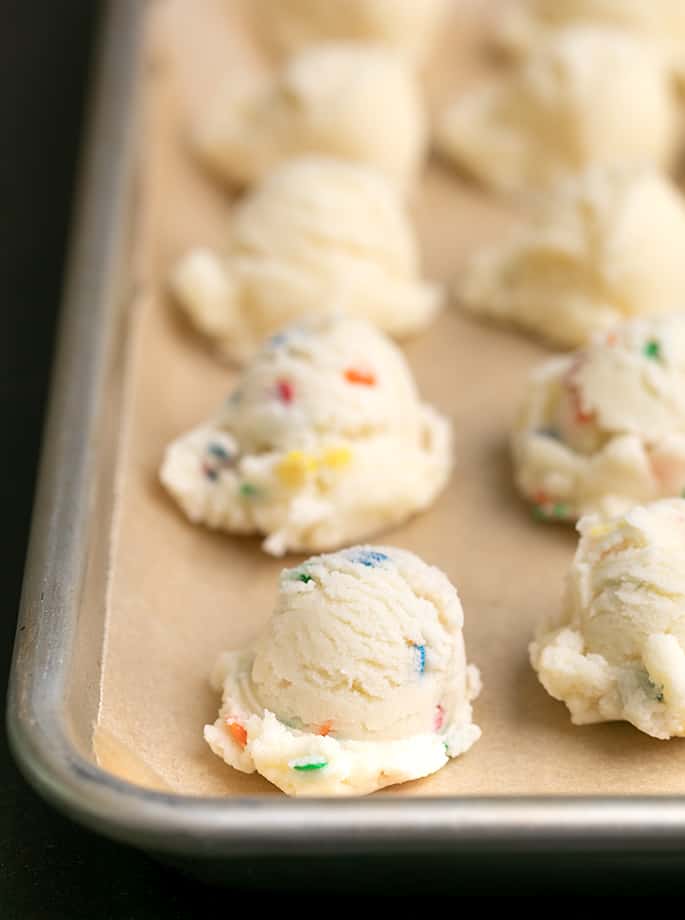
Can I bake this gluten free cookie dough?
No. This gluten free cookie dough is not designed to be baked. It wouldn’t hold its shape or taste very good at all.
If you’re looking for little gluten free chocolate chip cookie bites, I have a recipe I think you’ll love. They’re baked just until they’re no longer raw, just until they’re perfectly tender with absolutely no crisp edges.
Making multiple batches of this ‘raw’ recipe reminded me so much of the baked chocolate chip cookies bites that I made a big batch of them right afterward. That recipe for those mini cookies freezes really well, and they’re lovely straight from the freezer.
Can I add this gf edible cookie dough to ice cream?
Absolutely! To add your raw homemade cookie dough to your favorite ice cream, just make your dough bites much smaller.
How long will frozen gluten free edible cookie dough last?
So long as you’ve properly sealed your gf cookie dough bites in an airtight container to protect against freezer burn, your dough will stay good for up to three months.
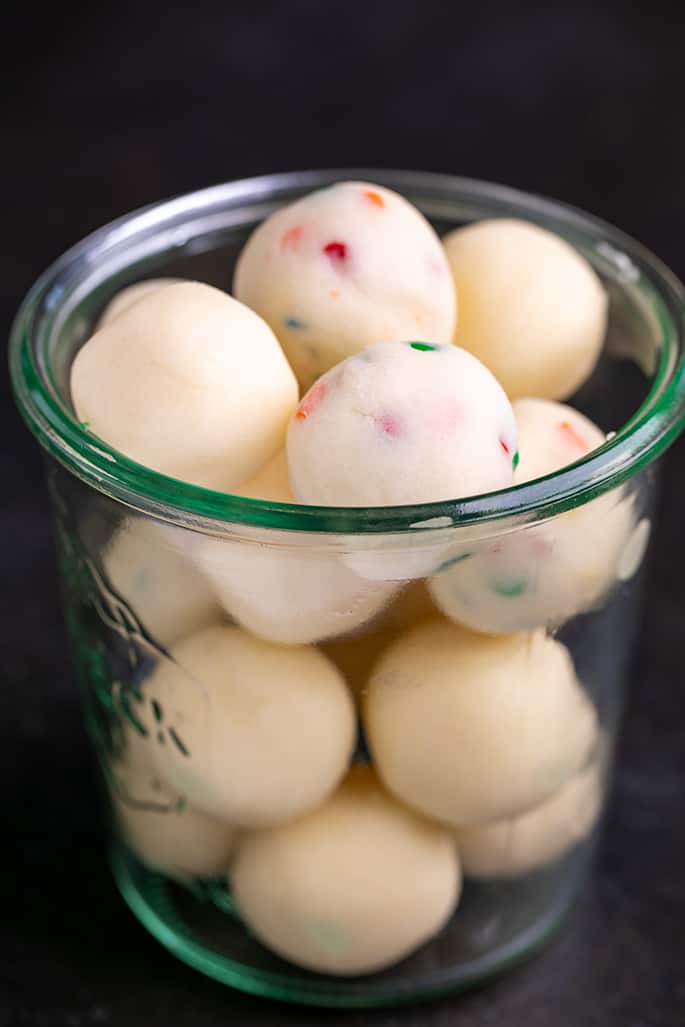
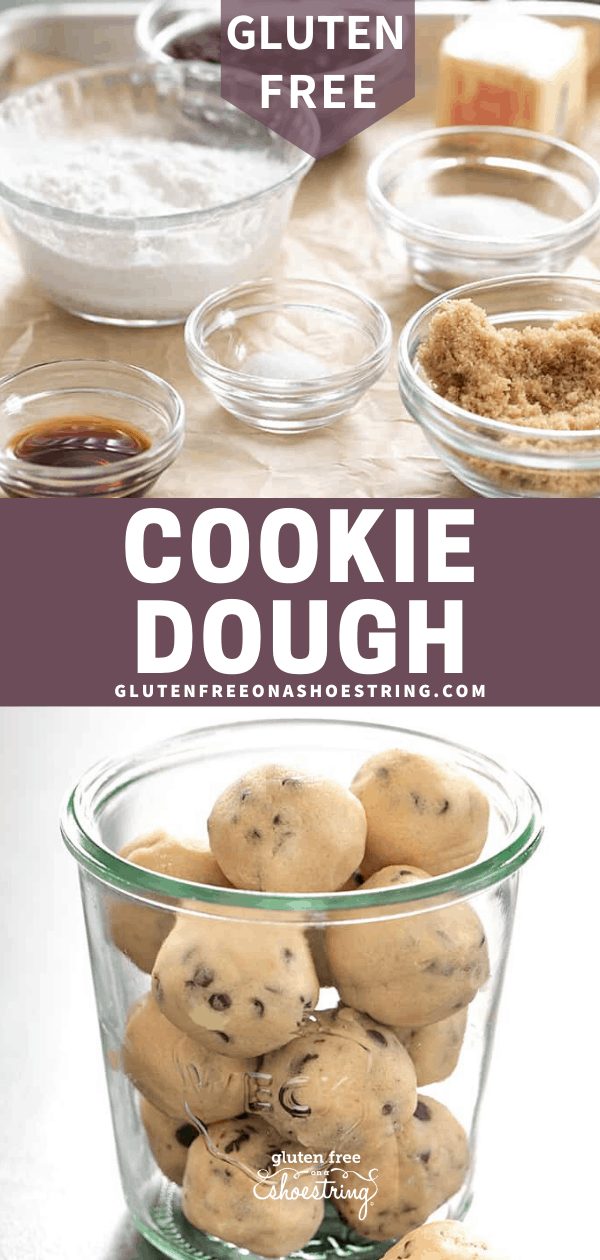

Edible Gluten Free Cookie Dough Recipe | No Eggs!
#wprm-recipe-user-rating-0 .wprm-rating-star.wprm-rating-star-full svg * { fill: #343434; }#wprm-recipe-user-rating-0 .wprm-rating-star.wprm-rating-star-33 svg * { fill: url(#wprm-recipe-user-rating-0-33); }#wprm-recipe-user-rating-0 .wprm-rating-star.wprm-rating-star-50 svg * { fill: url(#wprm-recipe-user-rating-0-50); }#wprm-recipe-user-rating-0 .wprm-rating-star.wprm-rating-star-66 svg * { fill: url(#wprm-recipe-user-rating-0-66); }linearGradient#wprm-recipe-user-rating-0-33 stop { stop-color: #343434; }linearGradient#wprm-recipe-user-rating-0-50 stop { stop-color: #343434; }linearGradient#wprm-recipe-user-rating-0-66 stop { stop-color: #343434; }
Ingredients
For the gluten free chocolate chip cookie dough
- ½ cup gum free gluten free flour blend
- 4 tablespoons unsalted butter at room temperature
- 2 tablespoons granulated sugar
- 3 tablespoons light brown sugar
- ¼ teaspoon kosher salt
- ½ teaspoon pure vanilla extract
- 1 ½ ounces miniature semi sweet chocolate chips
For the gluten free sugar cookie dough
- ½ cup gum free gluten free flour blend (46 grams superfine white rice flour + 15 grams potato starch + 8 grams tapioca starch/flour)
- 4 tablespoons unsalted butter at room temperature
- ⅜ cup granulated sugar
- ¼ teaspoon kosher salt
- 1 teaspoon pure vanilla extract
- 1 ½ tablespoons edible gluten free confetti or sprinkles optional
Instructions
For each variation
-
Line a small rimmed baking sheet with anything nonstick (parchment paper, plastic wrap, waxed paper).
-
Make sure the baking sheet is small enough to fit into your refrigerator. Set it aside.
For the gluten free chocolate chip cookie dough
-
Heat-treat the flour. You can heat it in the microwave, or in the (toaster) oven. (See Recipe Notes for instructions)
-
In a medium-size bowl, place the butter, granulated sugar, brown sugar, and salt, and mix with a fork until well-combined.
-
Add the vanilla and mix again to combine. The mixture will be rather soft.
-
Add the heat-treated, cooled flour, and mix until completely combined.
-
Add the chocolate chips, and mix until evenly distributed throughout the flour.
-
Scoop the dough into pieces, about 2 teaspoonsful each, and roll each into a ball. Place about an inch apart on the prepared baking sheet.
-
Place the baking sheet in the refrigerator and chill for at least 30 minutes or until firm before transferring to a sealed container.
-
Store in the refrigerator, until you're ready to serve the bites.
For the gluten free sugar cookie dough
-
In a medium-size bowl, place the butter, granulated sugar, and salt, and mix with a fork until well-combined.
-
Add the vanilla and mix again to combine. The mixture will be rather soft.
-
Add the heat-treated, cooled flour, and mix until completely combined.
-
Add the optional edible confetti or sprinkles and mix until they're evenly distributed.
-
Scoop the dough into pieces, about 2 teaspoonsful each, and roll each into a ball. Place about an inch apart on the prepared baking sheet.
-
Place the baking sheet in the refrigerator and chill for at least 30 minutes or until firm before transferring to a sealed container.
-
Store in the refrigerator, sneaking one here and there as the mood strikes.
Video
Notes
Grease or line a flat, wide microwave-safe bowl, and place the flour in it. Place the bowl in the microwave and heat it for 30 seconds at 800 watts (for my microwave, that means 30 seconds at 70{5676e3b156b07d12bd9df9fe13d641a85da396026abde11a1ff2d0afc1b3c015} power).
Using an instant-read thermometer, test the flour temperature. Microwave again at the same power in 10 second increments until the flour reads 165°F on an instant-read thermometer.
Set the flour aside to cool completely, and sift out any lumps, if necessary.
How to treat the flour in the (toaster) oven.
Line a small, rimmed baking sheet with parchment paper. Use a spatula to spread the flour out on the paper into an even layer.
Preheat the (toaster) oven to 250°F. Place the baking sheet in the (toaster) oven, and allow to heat for 90 seconds.
Remove the baking sheet from the oven, turn the flour over with the spatula a bit, and test it with an instant-read thermometer. If you’ve reached 165°F, set the flour aside to cool.
Repeat for 15 second intervals until the proper temperature is reached.
Set the flour aside to cool completely, and sift out any lumps, if necessary.
Concept of heat-treating the flour in the microwave adapted from Food 52.
Originally published on the blog in May 2020. In 2021, sugar cookie version added, second method for heat-treating flour added; some photos new. In 2023, new text resources added.
The post Edible Gluten Free Cookie Dough Recipe | No Eggs! appeared first on Gluten Free on a Shoestring.


